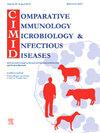人类和牛群中流产布鲁氏菌和梅毒布鲁氏菌的流行率及相关风险因素:一项综合研究。
IF 2
3区 农林科学
Q4 IMMUNOLOGY
Comparative Immunology Microbiology and Infectious Diseases
Pub Date : 2024-11-13
DOI:10.1016/j.cimid.2024.102276
引用次数: 0
摘要
布鲁氏菌病是南亚地区特有的一种人畜共患病,造成了严重的公共卫生和财政问题,尤其是在巴基斯坦。这项研究旨在确定巴基斯坦开伯尔-普赫图赫瓦省南部地区人和牛体内流产布鲁氏菌和瓜氏布鲁氏菌的分子频率,并找出相关的风险因素。研究人员共收集了 800 份血样,其中 600 份来自牛,200 份来自人,并使用针对 IS711 基因座的传统 PCR 技术对血样进行了检测。在人类中,布鲁氏菌和流产布鲁氏菌的分子频率为 16.5%;在牛中为 9.1%。对牛的风险因素分析表明,季节性、地理位置、性别和人工授精方法对布鲁氏杆菌病的流行有显著影响--雌性牛、自然受精的牛、夏季的牛,尤其是在班努等地区,风险较高--在人类中,单变量逻辑回归确定了潜在的风险因素,包括年龄(25-50 岁)、农村居民、较低的社会经济地位、女性、直接接触动物和食用未加工的动物产品。然而,这些因素均未达到统计学意义。这些发现强调了持续监测和有针对性的预防措施对控制布鲁氏菌病在牛与人之间传播的重要性。了解分子流行率和风险因素可以指导公共卫生策略,改善牲畜管理方法,从而减少这种人畜共患病的发生。本文章由计算机程序翻译,如有差异,请以英文原文为准。
Prevalence and associated risk factors of Brucella abortus and Brucella melitensis in humans and cattle populations: A comprehensive study
A zoonotic disease unique to South Asia, brucellosis causes major public health and financial problems, notably in Pakistan. This research aimed to ascertain the molecular frequency of Brucella abortus and Brucella melitensis in humans and cattle and to pinpoint related risk factors in the Southern Khyber Pakhtunkhwa, Pakistan, districts. A total of 800 blood samples, 600 from cattle and 200 from humans, were gathered and examined using traditional PCR targeting the IS711 locus. In humans, the molecular frequency of Brucella melitensis and Brucella abortus was 16.5 %; in cattle, it was 9.1 %. Risk factor analysis in cattle revealed that seasonality, geographic location, sex, and insemination method significantly impacted brucellosis prevalence· Higher risk was observed in female cattle, those naturally inseminated, and during the summer months, particularly in regions such as Bannu· In humans, univariate logistic regression identified potential risk factors, including age (25–50 years), rural residency, lower socioeconomic status, female gender, direct contact with animals, and consumption of raw animal products. However, none of these factors reached statistical significance. The findings underscore the importance of continuous surveillance and targeted preventive measures to control brucellosis transmission between cattle and humans. Understanding the molecular prevalence and risk factors can guide public health strategies and improve livestock management practices to mitigate this zoonotic disease.
求助全文
通过发布文献求助,成功后即可免费获取论文全文。
去求助
来源期刊
CiteScore
4.60
自引率
0.00%
发文量
102
审稿时长
40 days
期刊介绍:
Comparative Immunology, Microbiology & Infectious Diseases aims to respond to the concept of "One Medicine" and to provide a venue for scientific exchange. Based on the concept of "Comparative Medicine" interdisciplinary cooperation between specialists in human and animal medicine is of mutual interest and benefit. Therefore, there is need to combine the respective interest of physicians, veterinarians and other health professionals for comparative studies relevant to either human or animal medicine .
The journal is open to subjects of common interest related to the immunology, immunopathology, microbiology, parasitology and epidemiology of human and animal infectious diseases, especially zoonotic infections, and animal models of human infectious diseases. The role of environmental factors in disease emergence is emphasized. CIMID is mainly focusing on applied veterinary and human medicine rather than on fundamental experimental research.

 求助内容:
求助内容: 应助结果提醒方式:
应助结果提醒方式:


